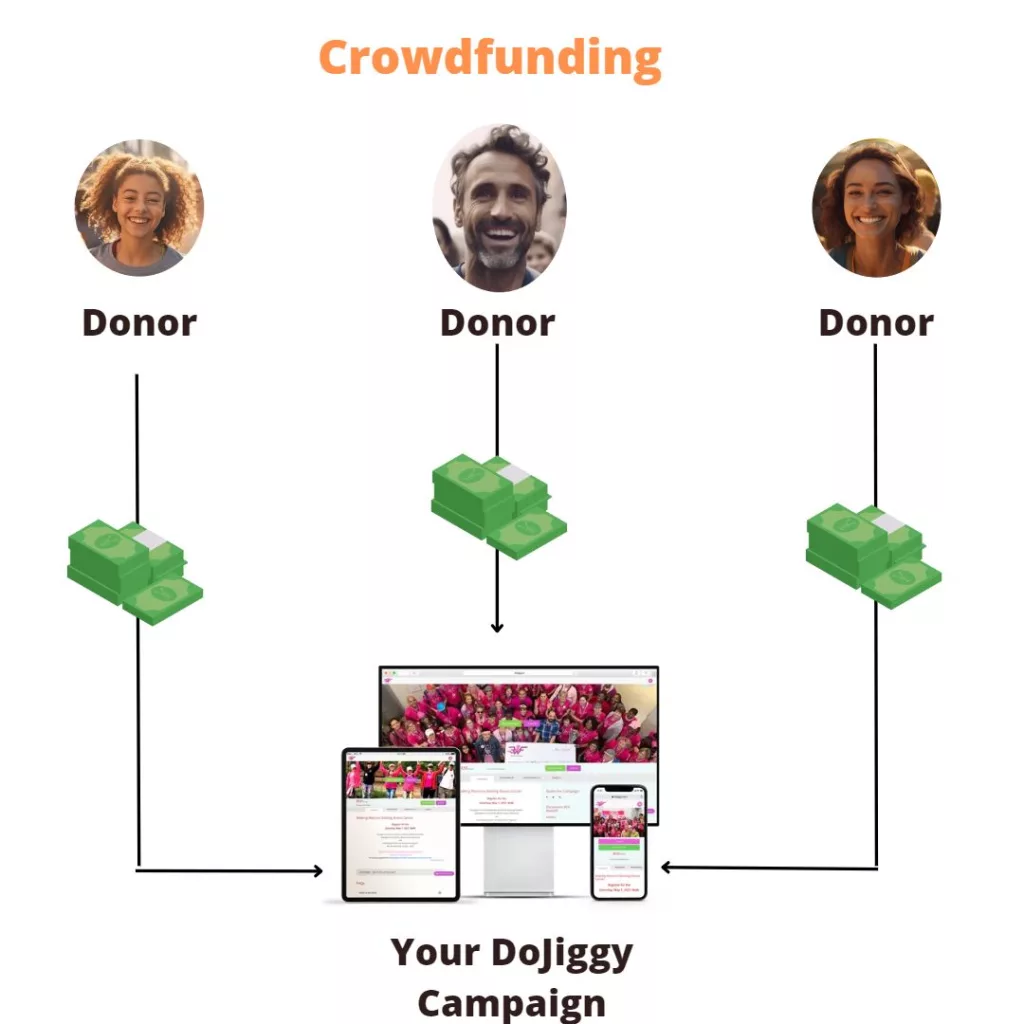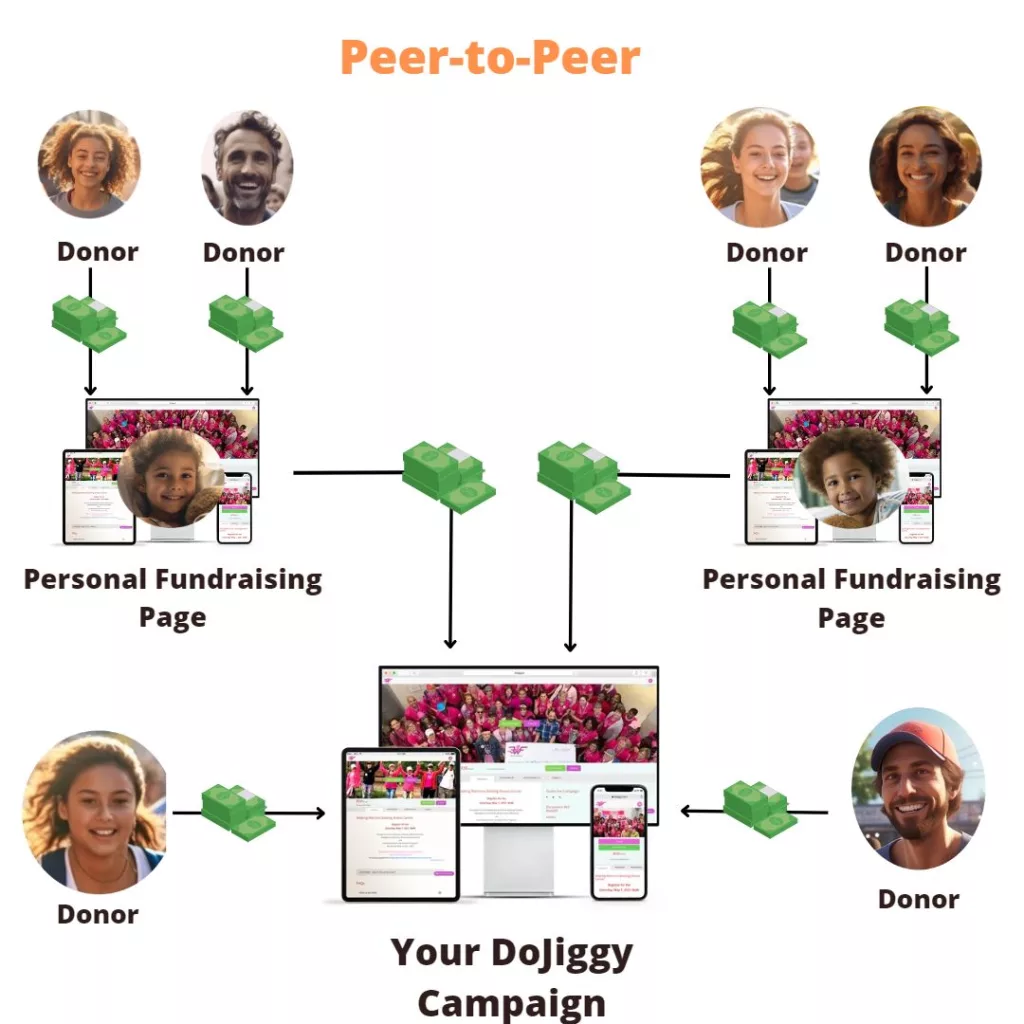
Crowdfunding and peer-to-peer fundraising are two of the most powerful tools in a nonprofit’s arsenal. These fundraising strategies utilize stories and personal connections to attract and engage supporters. But what is the difference between the two strategies, and how do you know which one to choose to best catapult your cause to success?
In this blog, we’ll take a closer look at what differentiates peer-to-peer and nonprofit crowdfunding, explore the benefits of each fundraising method, and discuss how to choose the right approach to maximize your campaign’s success.

What We’ll Cover
Peer-to-Peer Fundraising vs. Crowdfunding: Understanding the Difference
Crowdfunding involves gathering financial contributions from a large number of people, typically via the internet. It’s like casting a wide net, with the fundraiser directly appealing to a broad audience for support. This method is often used by individuals, startups, and charitable organizations for a range of causes, from funding a personal project to supporting a social cause. Here our focus is on nonprofit crowdfunding, where your organization appeals to supporters directly.

Peer-to-peer fundraising is a type of crowdfunding that is a more network-centric strategy. Here, a group’s supporters are empowered to raise funds on behalf of the organization. It’s like creating a web where each strand can branch out and connect to more and more people, leveraging their personal networks for support. So instead of a nonprofit making the appeal directly, supporters make the appeal to friends and family members on behalf of the organization.

Examples of Crowdfunding and Peer-to-Peer Fundraising
To give you a clearer idea of the difference between crowdfunding and peer-to-peer fundraising and to help you decide which strategy to use, let’s look at some of the most common fundraising campaigns for each.
Crowdfunding

- Program Funding: Nonprofits often use crowdfunding to raise funds for specific programs or initiatives. For example, an animal shelter might launch a crowdfunding campaign to expand its facilities, or a youth organization might raise funds for a new after-school program.
- Project Funding: Crowdfunding can be used to raise funds for specific projects, such as building a new community center or launching a new educational initiative.
- Disaster Relief: In the wake of natural disasters or other emergencies, nonprofits often turn to crowdfunding to quickly raise funds for relief efforts.
- Capital Campaigns: Nonprofits might use crowdfunding as part of a larger capital campaign, such as raising funds for a new building or significant renovation.
- Awareness Campaigns: Sometimes, the goal of a crowdfunding campaign isn’t just to raise funds but also to raise awareness about a particular issue or cause. For example, a nonprofit focused on conservation might launch a crowdfunding campaign around Earth Day to raise money while drawing attention to environmental issues.
Remember, the key to a successful nonprofit crowdfunding campaign is to clearly communicate what the funds will be used for and how they will benefit the community or nonprofit cause.
Peer-to-Peer Fundraising

- Charity Runs/Walk-a-thons: One of the most common uses of peer-to-peer fundraising is charity fun runs and walk-a-thon fundraisers. Participants commit to participating in the walk and ask their friends and family members to sponsor them.
- Birthday Fundraisers: Instead of receiving gifts, some people ask their friends and family to donate to a chosen nonprofit in honor of their birthday.
- Fundraising Challenges: Some nonprofits organize challenges, like a dance-a-thon or bake-off, where participants raise funds from their network to participate.
- Memorial Fundraisers: In memory of a loved one, individuals can launch peer-to-peer fundraising campaigns to support a cause the departed cared about.
- Special Occasion Fundraisers: Holidays, anniversaries, or milestones can be great occasions for peer-to-peer fundraisers. For instance, during the holiday season, individuals can encourage their friends and family to make a donation as a gift to a nonprofit.
- Advocacy Campaigns: Individuals passionate about a cause can leverage their network to raise funds and awareness. For example, during a health awareness month, supporters could start peer-to-peer fundraisers to support related nonprofits.
In each case, the key to social fundraising is to tap into supporters’ personal networks, multiplying the fundraising impact for the nonprofit.
Crowdfunding and Peer-to-Peer Fundraising Tips
Whether you choose crowdfunding or peer-to-peer fundraising, certain tactics can help you succeed. Here, we’ve included essential advice for both strategies, ensuring you’re well-prepared to manage a powerful and memorable campaign.

- Craft a Compelling Story: Your campaign needs to capture people’s attention and touch their hearts. A compelling story can do just that.
- Equip Your Supporters: Provide your donors with the tools and resources they need to fundraise effectively on your behalf.
- Keep Communication Open: Regular updates about the campaign’s progress and milestones keep the momentum going and make fundraisers feel part of the mission. Remember – transparency builds trust and maintains engagement.
- Show Appreciation: Show gratitude to your volunteers and fundraisers and show them the difference their contribution makes. A simple thank you can go a long way.
Crowdfunding and Peer-to-Peer Fundraising: The Benefits of Each
Crowdfunding and peer-to-peer campaigns both have unique advantages, which can make one of these fundraising strategies a better fit for certain situations.
Benefits of Crowdfunding

- More Control: Crowdfunding campaigns are managed at the organizational level, where the campaign’s messaging, branding, and overall execution are defined.
- Direct Appeal: As the fundraiser, you can maintain a direct connection with your supporters.
- Versatility: Crowdfunding can be used for various causes, from launching a new product to supporting a local charity. In this article, we are focusing on crowdfunding for nonprofits and charitable organizations.
Benefits of Peer-to-Peer Fundraising
- Network Leverage: Peer-to-peer fundraising taps into a network of supporters, exponentially expanding your reach beyond current supporters.
- Personalized Appeals: Supporters raising funds can personalize their appeals, making them very effective.
- Community Building: This method encourages engagement and community building, as everyone feels part of the mission. P2P campaigns pair well with Run/Walk/Ride community events.
Last Thoughts on Peer-to-Peer Fundraising vs. Crowdfunding
Though they are often used interchangeably, peer-to-peer is a type of crowdfunding that engages your supporters to raise money for your cause. Organizations with a strong supporter base can benefit greatly from crowdfunding campaigns, especially when peer-to-peer fundraising is employed. Whether you choose nonprofit crowdfunding or peer-to-peer fundraising for your campaign, remember that the most effective donation drives connect with people on a personal level.
![16 Best Fundraising Platforms for Nonprofits [2024] 16 Best Fundraising Platforms for Nonprofits [2024]](https://www.dojiggy.com/files/sites/164/2022/07/best-fundraising-platforms-for-organizations-1-425x264.webp)
![Benefits of Peer-to-Peer Fundraising [+ Disadvantages] Benefits of Peer-to-Peer Fundraising [+ Disadvantages]](https://www.dojiggy.com/files/sites/164/2023/06/benefits-of-peer-to-peer-fundraising-423x282.webp)

